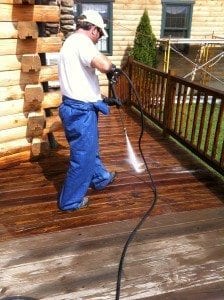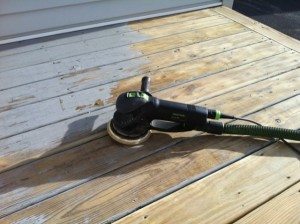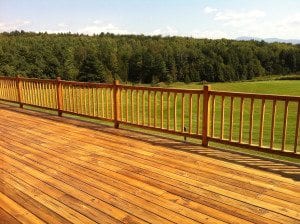A Seasonal Checklist for Decks…
Decks are a great outdoor living space to enjoy for both relaxing and entertaining during three seasons of the year. In addition to the general traffic wear and tear that decks endure, they are also exposed to the most brutal of outdoor elements. Rain, sun, snow and ice wreak havoc on horizontal outdoor wood surfaces.
Signs that your deck is weathering and in need of maintenance will usually include:
- Fading and turning gray
- Water stains
- Formation of green, slippery mildew
- Splitting and “checking” of the grain
Basically, if you are no longer comfortable walking barefoot on your deck, it is time to do something about it. Best practice is to inspect for these conditions in both spring and fall of each year.
If your deck is in need, there are two practical methods to prepare it for a fresh coat of stain:
Pressure Washing

This is not about using high pressure water to blast contaminants and discoloration out of the surface. If done incorrectly, this can really damage your wood. Pressure washing should only be done as a rinsing method after applying a deck cleaning solution that is formulated to chemically restore wood to its original, healthy state.
We recommend using a liquid form deck cleaner or brightener applied with a garden style pump sprayer, then rinsed thoroughly with a pressure washer, using the green colored tip that comes with the machine. Allow a couple of good days of drying time before applying a fresh coat of deck stain, following the manufacturer’s instructions for application as printed on the can label.
Sanding
If chemical cleaning is not for you, another option is to prep your deck mechanically, using a power sander.

If your deck is not too large, this is a quick way to do it. By sanding instead of pressure washing, you do not have to wait for your deck to dry before applying the new coat of stain – it can be done immediately after sanding.
Typically, one round of sanding at 80 grit is sufficient, and with a power sander attached to a vacuum, the process is clean and the results more crisp, as dust particles aren’t ground into the wood grain. Stains penetrate best and have the richest look with this method.
Definitely be sure to wear knee pads if you choose to sand your deck, it will make the process much easier on your body.
Product Selection
There are many choices in deck finishing products these days, and the choice really comes down to aesthetics and performance.

If your deck is a pretty species of wood, such as cedar, fir, ipe or mahogany, you may decide to use a clear or semi-transparent stain to protect the wood and allow the grain to show through.
This type of finish requires a bit more maintenance over time – as in annually – but is definitely more a more appealing feature than a solid stained deck.
On the other hand, older pressure treated decks, for example, are not that visually interesting. The wood is just not very pretty to look at. So in this case, it is usually best to opt for a semi-solid or solid color stain to protect the wood best and also to provide the lowest maintenance over time. There is nothing wrong with the deck just being a nice looking color.
Whichever route you choose, be sure to use a good quality brush and apply liberally. It is best to stain two or three courses at a time, over the full length of the deck. This approach helps to avoid overlap marks. If you keep the boards wet as you go, and move at a rigorous pace, the coverage will be just right.
Oil or Water Based?
Historically, oil stains were the best and only legitimate choice for deck finishing. That has all changed in recent years as water based formulations have come a long way in terms of ease of use and performance.
Oil based stains are slower drying, which results in more down time for your deck. They also require the use of paint thinner to clean brushes, and can be very difficult to remove from your hands after the project is complete. While oils are still the popular option on exotic deck wood species, for most common applications, it is not necessary anymore.
Water based deck stains are the safer alternative these days and are much easier to use. The application and cleanup are easy, and they do not fade like oils as they age.
Looking to Drill Deeper into Deck Information?
While this article is a general overview, I have launched a new and more comprehensive resource for deck owners, builders and finishers. It is called ipehelp.com. The new site is geared to owners of exotic wood decks in particular, and also has lots of valuable info, tips and resources for wood deck lovers in general.
Maintaining your deck is the key to its durability, so feel free to peruse the archives at Ipe Help and educate yourself. If you feel that you are in over your head with a deck situation of any type, I am available for consultation through that site.

